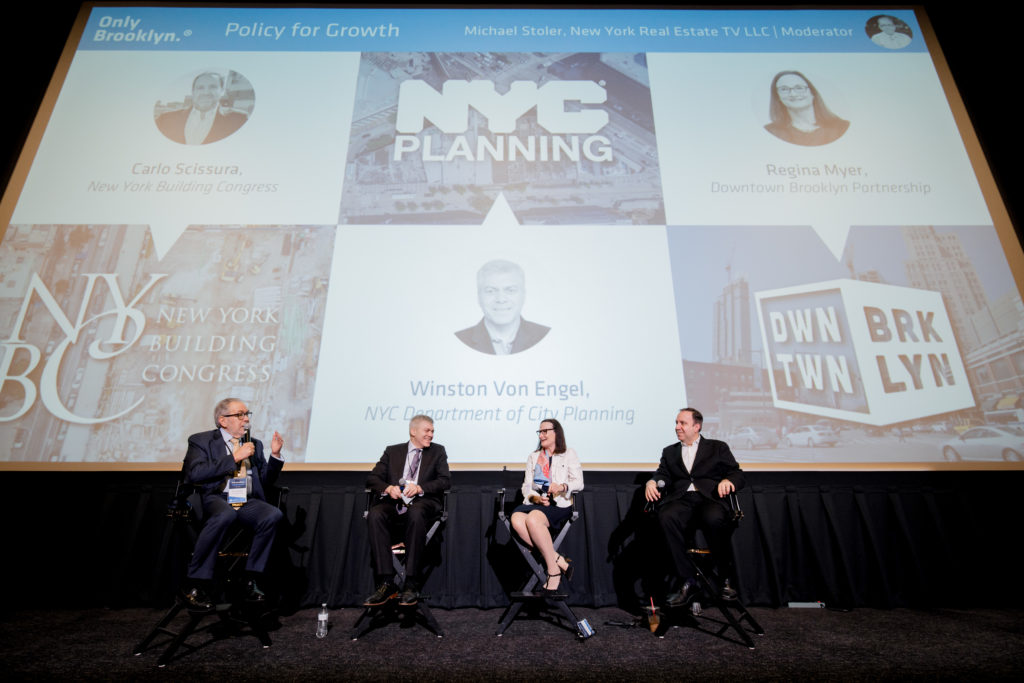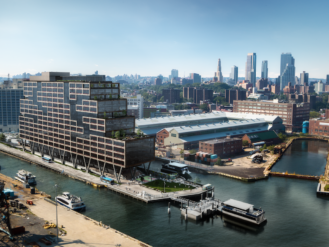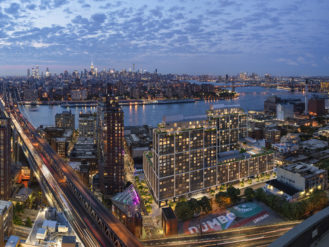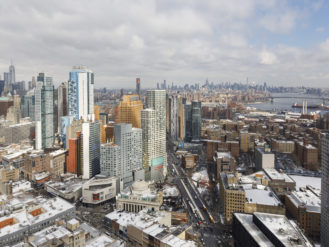Real-estate Developers Say Community Is a High Priority
At a Brooklyn conference, industry leaders professed a focus on neighborhood needs, but expressed concern about overzealous regulation
Eran Chen of the architectural firm ODA makes a point at the Only Brooklyn conference (Photos by BojanHohnjecStudio for TerraCRG)
“We recognize real estate here is more about people than it is about dirt,” Jared Della Valle, CEO of the Brooklyn real-estate development firm Alloy, said this week in a meeting of his industry colleagues. “We’re starting to address the community, and to think about the needs of place in a much more relevant way—issues of affordability, domicile, and what real estate really is about, which is the fundamental need for home.”
Della Valle has learned a thing or two about fitting into the borough, as the developer behind the award-winning One John St. condo building in Dumbo and the much-debated 80 Flatbush mega-project in Downtown Brooklyn. His comments summed up an essential challenge in real-estate development today, especially in a borough where gentrification is a charged political issue. Developers need to embrace community needs, while navigating economic forces and a changing regulatory climate, he and his fellow speakers said at the Only Brooklyn real-estate conference this week at the Alamo Drafthouse Cinema in City Point.
The annual conference took place against a backdrop of continued growth in the Brooklyn market, even if the feverish rise in residential prices has cooled off. A first-quarter report from Corcoran showed residential-sales volume easing, while StreetEasy reported high rental demand—three of the hottest six neighborhoods across the city were Dumbo, Downtown Brooklyn and Brooklyn Heights. The city’s third- and fourth-largest new residential developments will be in Brooklyn, at 545 Vanderbilt Ave. and 1911 Atlantic Ave., reported The Real Deal.
On the commercial-property side of the business, a 2018 year-end market report published by TerraCRG, the firm that hosts the Only Brooklyn conference, showed strong growth. “The Brooklyn commercial real estate market remains active with $7.4 billion in total dollar volume, a 15% uptick from 2017. That figure is consistent across a five-year basis,” the report said. “This activity has foreshadowed what has already been a vibrant start to 2019.”
Development Will Be Dynamic
It was under such favorable conditions that several hundred members of the local real-estate industry gathered to discuss the borough’s future, starting with a panel titled “Brooklyn’s New Vision,” moderated by TerraCRG founder Ofer Cohen. After developer Della Valle spoke about community needs, Cohen called on Eran Chen, founding principal of ODA architecture for insight into how this cooperation could manifest itself. Chen’s firm is behind Denizen, a mixed-use complex on the site of the old Rheingold Brewery in Bushwick that will include 20% of its residential units deemed affordable, communal spaces, a public park, and commissioned art by local artists.
“There’s three main principles that are relevant to people today,” Chen began. “The first one is a balance of density and open space. And that’s something we all know about, but we tend to forget as we develop cities [and] quality public spaces. The other thing is infrastructure, and the third thing is people want to live in a mixed-use environment.”

Chen noted that parts of Manhattan are so dense that it is extremely challenging for developers to implement these refined spaces with desirable personalities. “Brooklyn provides us the opportunity to actually rethink those priorities and do it the right way, in a way that addresses people’s needs of today and how people want to live today.”
Jeff Mandel, head of acquisitions at Tishman Speyer, a Manhattan real-estate giant that’s constructing an office tower atop the Macy’s building on Fulton Mall, took the conversation down a more tech-centered path. “What I would imagine moving forward for Brooklyn is that it’s a place really characterized by innovation. We have innovative people here,” he said. “So what I’m really thinking about is there will be a more mature economy of businesses that choose to make Brooklyn their home, and that’ll potentially be a function of the engines and the people that are already here, starting businesses—not unlike Etsy, for example.”
Fortunately, Brooklyn appears to be an ideal place for developments meeting such a variety of needs. “You go around the world, every great city is a collection of great neighborhoods. [In Brooklyn] you have that, so you have a phenomenal canvas, naturally,” said Ben Brown, head of New York for Brookfield Property Partners, a global real- estate investment firm. “Now you have a lot of capital being invested in these different pockets to create these neighborhoods and take that maturation process on. I think the future of these particular neighborhoods will evolve and change, and [yet] continue to be distinctly themselves.”
After the panel wrapped up, The Bridge asked Cohen about the relative importance of real-estate developers being conscientious community partners. “There’s a level of commitment that Brooklyn is a place that we need to continue to shape, and I think that gives you [a sense of] responsibility,” he said. Local developments popping up today, he continued, are better fits for the area because the people involved in cultivating them are “understanding the economics, the demographics, the changes and the shifts from within” the borough.
Are Regulations Becoming Excessive?
In another panel, “Policy for Growth,” moderator Michael Stoler, president of New York Real Estate TV, asked panelists about the futures of specific Brooklyn neighborhoods and the impact of new city regulations, including the Climate Mobilization Act, which will require sharply reduced building emissions. Stoler asked: “How do we get growth when we have all this potential legislation?”
“Of course everybody wants to live in a green world,” said Carlo Scissura, CEO of the New York Building Congress, a construction-industry trade association. “People like all of you in this room, and people like us [on the panel] really need to let the elected [officials] know … that one regulation is O.K. But now that it’s added up to eight, 10, 12, 15 regulations, the sunny skies of Miami are looking pretty good, the warm weather of Texas is not bad. We all have to really come together and say enough is enough.”
Good for Business: Rezonings and Transit
While the prospect of taking their business elsewhere may be tempting, other regulatory developments in the city provide opportunities, notably the rezoning of neighborhoods for broader uses. Winston Von Engel, director of the Brooklyn borough office of the Department of City Planning, pointed to the recent rezoning of East New York as a promising indicator that plenty more rezonings—and, thus, developments—are on the way. “We kind of held our breath [as to] whether it would take, and it’s taking,” Von Engel said, speaking on behalf of his department and the mayor’s office.
“The private sector is actually responding—they’re building, they’re developing sites and building housing with affordable housing.” He added that retail is returning to East New York as well, and that the city is building a new school there, though he later admitted, “It’s going to take some time” for the neighborhood to evolve to the potential its rezoning affords.

Stoler asked which recently proposed zoning plans were the most likely to pass. Von Engel emerged bullish on Gowanus. “That’s one of the imminent rezonings,” he said. “We just put out a zoning framework; we had our environmental kickoff meeting just a few weeks ago.” While local residents criticized the plan at that meeting, calling for environment cleanup of the toxic Gowanus Canal to be emphasized over residential development, Von Engel portrayed Gowanus as brimming with potential.
“I think Gowanus is a great example of an effort to refresh and revitalize an area, and there’s something unique and new about it.” Von Engel noted the distinct mix of industrial and commercial buildings already present there, supplying walk-to-work possibilities for residents. “That’s what [the Gowanus rezoning] is about—the mixing of the uses, and actually increasing and innovatively allowing for a new creative industrial district to foster more job growth as well as housing.”
Though Downtown Brooklyn has been revitalized the past decade or so, Regina Myer, president of the Downtown Brooklyn Partnership, which manages the three business-improvement districts in the area, said more improvements are still being considered—also by way of rezoning. “We have 15,000 new housing units in Downtown Brooklyn; we have an entirely dynamic downtown, which we did not have 15 years ago,” Myer said. “What we need now is more office space.” (An earlier rezoning produced abundant residential towers, but not the expected office buildings.)
Myer said new upzonings could propel projects like 625 Fulton Street, a proposed 941-foot tower with 739,000 sq. ft. of office space, and 570 Fulton Street, a 40-story mixed-use building; and a planned 500,000-sq.-ft. development, also along Fulton Street. Such additions could give Downtown Brooklyn the chance to have a “true office center” and help boost the neighborhood’s recently moved-in retail stores.
The panel also discussed how improvements in transit, including the lingering prospect of the BQX streetcar, which would run from Astoria, Queens, through Gowanus; ferries between Manhattan and Coney Island, Red Hook, and other Brooklyn enclaves; and the soon-to-open second span of the Kosciuszko Bridge, should have a noteworthy positive impact on development in those benefitting areas.
The brightening prospect for transit prompted Scissura to declare: “Endless opportunities are out there” for development. Asked after the panel to reconcile that idea with his concerns about regulation, Scissura said, “It’s still New York, and people still want to be here. So I think our job, collectively, is to say, as regulations are announced or talked about, ‘How do we continue to make sure that they are not stopping development and opportunity?’ I would like government to ensure that we’re doing things safely and in the right manner, but to not regulate every piece of this industry, so that we can see the continued boom in construction and development that we’re seeing today.”













